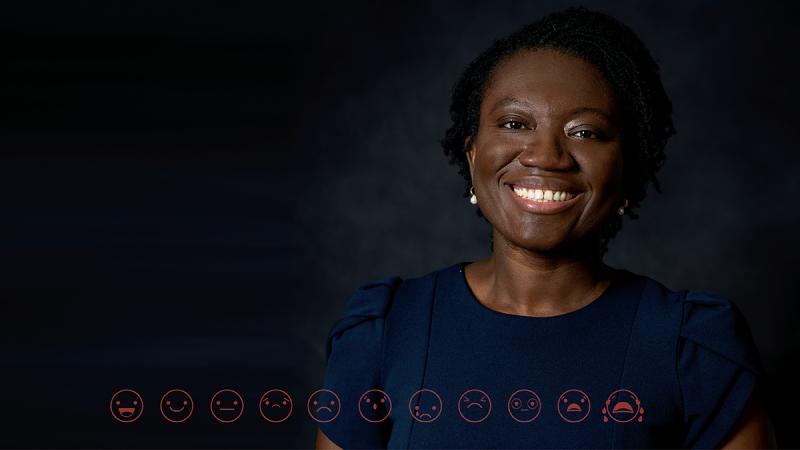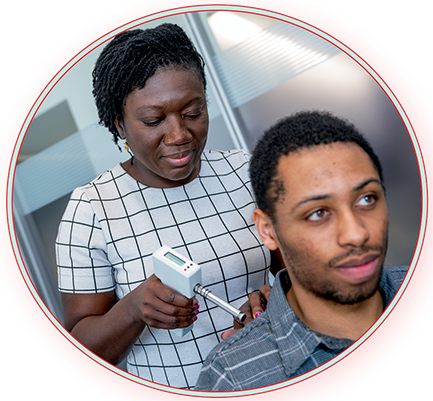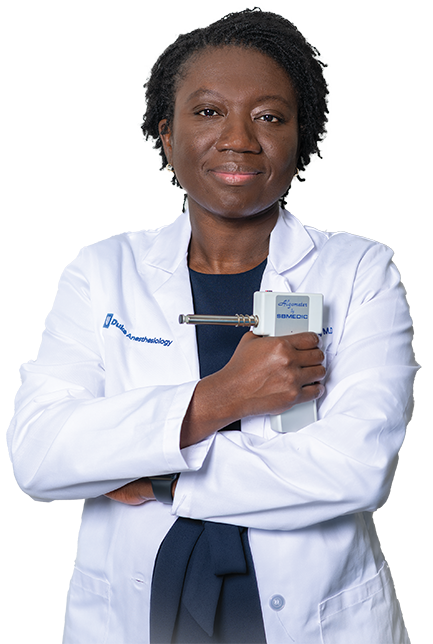
Persisting to Help Children in PAIN
Witnessing a childhood friend in severe pain from sickle cell disease left a lasting impression on Dr. Martha Kenney and set her on a path to helping others.
Seeing a child in severe pain is an unforgettable experience at any age, but for Martha Kenney, MD, an assistant professor of anesthesiology and pediatrics at Duke, it came early. Her childhood playmate in Ghana had sickle cell disease, an inherited blood disorder in which abnormal hemoglobin causes red blood cells to become sticky and C-shaped. When these cells move through small blood vessels, they can get stuck and clog blood flow, causing debilitating pain and other complications like infection, stroke, and eye problems.
Limited health care access in Ghana made it difficult for Kenney’s friend to receive treatment; watching her friend suffer from pain left her feeling powerless and helpless, which sparked Kenney’s interest in medicine. When her family moved to the United States when she was seven, she already knew that she would become a doctor who could help others like her friend. But what she didn’t know yet were the twists and turns that her career would take as she zeroed in on exactly how to help.
FINDING HER NICHE
Kenney’s family settled in northern Virginia, and she majored in biochemistry at Brown University before entering medical school at Johns Hopkins University. Early on, Kenney planned to train in hematology oncology to become a pediatric hematologist caring for sickle cell patients. But an experience in the National Institutes of Health’s Clinical Research Training Program between her third and fourth year of medical school changed her perspective.
“I encountered a really young patient who had metastatic leukemia that had pretty much spread everywhere,” recalls Kenney. His parents came to the United States from abroad, selling their possessions to try treatment after treatment before landing at the clinical center where Kenney worked to see if he could benefit from her mentor’s immunotherapy trials. Unfortunately, he was too sick and did not qualify.
“That brought back a lot of early memories from childhood because this child was in excruciating pain, and there wasn’t a lot that could be done for his pain,” says Kenney. “It got me thinking about how to best take care of children in those circumstances and provide relief for their pain.”
The field of anesthesiology appealed to her as a way to help children manage pain from sickle cell disease and other types of painful diseases as pediatric anesthesiologists are not only trained to provide specialized care in the operating room, but to manage pain after surgery.
After talking with her sickle cell research mentor, Dr. John “JJ” Strouse, who encouraged her to go for it, Kenney completed a combined residency in pediatrics and anesthesiology followed by a one-year fellowship in pediatric anesthesiology at Johns Hopkins University. Looking back, it was the best career change she could have made.
“When I decided to go into anesthesia, I felt a little unsettled at first because I had gone into medicine to make an impact on people who have sickle cell disease, and I wanted to remain true to this calling,” she says. “But JJ reassured me that going into anesthesia would present an opportunity for me to really develop a unique niche by focusing on research within sickle cell pain and that I could make a great impact in a different way.”
PERSISTENCE PAYS OFF
At the end of her fellowship training, Kenney landed a role as an assistant professor of anesthesiology and pediatrics at the University of North Carolina. There, she gained ample clinical experience and benefited from the mentorship of Dr. Jane Little, professor of medicine and director of the UNC Comprehensive Sickle Cell Disease program.
Kenney felt called to not only care for children with sickle cell disease, but to make strides in improving health care access and treatment options. She knew this would require research, and her busy day job in the operating room didn’t allow any time for such pursuits. There are also very few anesthesiologists doing research in the sickle cell disease pain space.
But, as the old adage goes, “if there is a will, there is a way.” In the mornings before work, Kenney scoured the latest sickle cell disease research papers, familiarizing herself with recent discoveries and applying to small grants that could jumpstart her research career. She even cold-emailed potential mentors.
“I had no mentors in the research space at that time. I was a clinician who worked in the operating room,” says Kenney. “So, I started going on NIH Reporter to find scientists working in sickle cell disease and pain, and I would just email them, tell them who I was, and that I was really passionate about sickle cell disease.”
Some never responded, but some did. Their encouragement led her to apply for and receive funding from the UNC Children’s Hospital and Dean’s Office to buy out some time in her daily schedule for research. Ultimately, she found a role at Duke Anesthesiology that allows her to spend 70 percent of her time on research and the rest caring for children in the operating room.
“My path was nontraditional,” Kenney says. “Most physician-scientists have a PhD in addition to the MD, or if not, they have some other type of formal research training. I didn’t have any of those things, and I think most people in my situation end up getting lost, but the thing I did have that I depended on the most was my drive and my sense of purpose.”
INNOVATIVE INSIGHTS
Since the FDA approval of gene therapy (a “cure”) for sickle cell disease (SCD), Dr. Kenney is often asked, “What are you going do in your research now?” She believes the future for SCD is filled with hope but should be approached with cautious optimism. Sickle cell disease is BOTH an inherited blood disorder and an acquired chronic pain disorder. It is possible for the blood disorder to be “cured” with gene therapy or bone marrow transplant and still have a significant number of individuals with chronic or persistent pain.
Dr. Kenney’s findings from large cross-sectional analyses of SCD:
- The burden of chronic pain is significant
- Adolescence and young adulthood are the greatest periods of vulnerability for high pain severity and pain impact
- Chronic pain appears to have a disproportionate impact on pain impact and pain-related disability compared to biological markers of disease severity
- To fully cure SCD, we need to work to prevent chronic pain, first understanding why it occurs
- The burden of disease doesn’t correlate with where there are resources to address the disease; there is limited understanding of chronic SCD pain in sub-Saharan Africa, the region where the majority of the disease is concentrated
- Curing SCD must be paired with addressing long-standing interpersonal and systemic stigma that has hindered access to care and led to poor outcomes
“Never let anyone decide for you — what dreams to have, or what your worth should be. Only you truly understand your journey. So, stand by your dream and protect it fiercely.”
- DR. MARTHA KENNEY

of an algometer to determine pain thresholds for pressure
application in soft tissue, muscles and joints.
UNDERSTANDING PAIN PROGRESSION
Since Kenney joined Duke in 2022, her research career has taken off, thanks in part to the invaluable guidance from two key mentors, Drs. Nirmish Shah and Francis Keefe, who have helped shape her trajectory and amplify her success. She received a five-year career development award from the National Institutes of Health – known as a “K” award – that provides support and mentorship for her research endeavors. Currently, Kenney is working to better understand sickle cell pain in adolescents and young adults.
She is tracking a cohort of people living with sickle cell disease between the ages of 15-40 for four years to better understand biological and psychosocial predictors for the development of severe and persistent pain in adulthood. For people living with sickle cell disease, acute pain can come on suddenly at any time and last for any length of time. Although it can happen in any area of the body, it commonly occurs in the hands, chest, feet, and back. Meanwhile, chronic pain is daily, ongoing pain that lasts for more than six months. The prevalence of chronic pain in kids is around 30 percent, but in adults, it is around 50-60 percent, notes Kenney.
“The risk of someone transitioning from acute to chronic pain significantly increases when they reach the adolescent period,” she says. “People in their mid-twenties and early thirties make up the bulk of patients being treated for pain in the health care system. The young adult period is a period of great vulnerability and that’s why I’m especially interested in studying it.”
Patients who transition from having episodes of acute pain to long-term chronic pain present a challenge to physicians trying to help them. Although opioids are effective in treating some episodes of acute pain, they are ineffective and potentially harmful for chronic pain, says Kenney. What’s more, the number one factor in a patient’s development of chronic pain is having acute pain that was treated poorly, leading to changes within the patient’s central nervous system.
“The chronic pain that they have is really hard to assess and hard to manage as well,” says Kenney. “In fact, emerging research shows that chronic pain can persist in the absence of sickle cell disease, after a patient has been cured of the disease by bone marrow transplantation or gene therapy.”
Kenney aims to secure funding to study an even larger population during this critical time of their lives. The research will help physicians develop personalized treatment plans to prevent the development of disabling, severe pain, she adds.
GUIDING PRINCIPLES to Building an Interdisciplinary Research Program:

Anesthesiologists interact with nearly every medical specialty and provide care in all corners of the hospital. Colleagues in the perioperative environment trust and look to anesthesiologists for their broad knowledge and expertise. Dr. Kenney believes that if anesthesiologists want to have a greater impact on public health, they must think broadly and see themselves as the true interdisciplinary leaders that they are.
Find and define the purpose of your research program
Science is both a discipline of reason and passion, so it’s important to be clear on what inspires you personally about your research endeavors.
Allow your research to go where there is a need that you are uniquely positioned to address
Ask yourself…Who are the people that I want to serve in my research? And why? What are their challenges and why do their problems matter to me? What solutions would be most valuable to them? Why do I feel connected to them? “Answering these questions is what took my research into the sickle cell clinic, a place that you would rarely see an anesthesiologist, but it’s where I saw the greatest opportunity to make that kind of impact I seek in my career and life.”
Build authentic and meaningful relationships with mentors and collaborators
This requires investment of your time and energy. You can’t rely on casual networking to seek the kind of mentors and collaborators that you need.
One mentor will not check all the boxes
One mentor is not enough because no one is an expert on everything, and you will have a different relationship with each mentor. What you need is a board of mentors and sponsors.
Deciding what not to do is equally as important as deciding what to do
The demands of academia can be overwhelming and even conflicting, but not every opportunity that comes along is the right one, or even comes at the right moment. So, it is important to learn the art of strategic refusal – a skill that helps you safeguard your time, energy and focus for what truly matters and aligns with the purpose of your research and career.
AN EYE TO THE FUTURE
As her research career continues to grow, Kenney aspires to explore many other questions related to sickle cell disease pain, and from all angles. From a biological perspective, she plans to use functional magnetic resonance imaging capabilities at Duke to explain how structural changes in the brain play a role in disease-related pain.
From an environmental perspective, Kenney and collaborators aim to look at the environmental influences of pain. Using geospatial data, they will evaluate if and how the place where someone living with sickle cell disease is located affects pain outcomes, in terms of access to sickle cell clinics as well as everyday exposures to pollutants.
From a social science perspective, she strives to better understand what drives a patient’s decision to participate in sickle cell clinical research and what can be done to make sure marginalized communities are better represented. She recently applied for funding from the Patient-Centered Outcomes Research Institute with an advocacy partner, Sickle Cell 101, to further explore this topic.
“This is a disease that affects marginalized black and brown people. And for quite a while, it seemed nobody cared. Historically, there have not been a lot of federal funds dedicated to research in sickle cell disease, but thankfully, over the last few years, this has started to change, and I want to see it continue to change.”
CULTIVATE a Meaningful and Fulfilling Career
The late Maya Angelou is credited with saying “success is liking who you are, what you do, and how you do it.” For Dr. Kenney, this quote highlights that career success and fulfilment is incredibly personal. She says for some, success is about recognition; for others, it is about contributing quietly in the background. Both perspectives are equally right since success and fulfilment have deeply personal meaning.
1. Be clear on who you are; continually seek greater awareness about your passions, strengths, weaknesses, etc.
2. Understand what truly matters to you, aka your values, and why
3. Be clear on what being authentic to what truly matters to you in your life and work looks and feels like for you
PAYING IT FORWARD
Kenney’s ultimate goal is to bring her work full circle back to Ghana through global health research collaborations. “My dream is to figure out how to take the things that I've learned here and see if they even apply in sub-Saharan Africa because it’s a different environment there and pain is treated very differently there,” she says.
Duke’s commitment to creating an environment that supports early career researchers has made all of the difference for Kenney. “When I mentor or coach people now, I always tell them that when you’re thinking about the next step—whether it be a new job or training location—consider whether the environment is going to nurture and grow your potential. You can have incredible talent but not really grow to your full potential because you’re just in the wrong environment. I’m blessed to be here at Duke.”

Hanging in Kenney’s home office is a sign that says “I can do anything, But I can’t do everything”—an idea that she often emphasizes as a career coach. If a new professional project doesn’t contribute to her ultimate goal of improving the lives of people from marginalized communities who are living with pain disorders, then it’s easy to say no.
“I’ve learned to draw boundaries and to be very clear about what’s important to me,” says Kenney, who is a devout Christian, wife, and mother to a seven-year-old daughter and four-year-old son.
“Really, I just want to make my kids proud. I want them to see me living out my values and the values that are important to our family. As a Christian, I don’t believe I’ve been given these opportunities by pure luck. I believe that God has a certain expectation and a call, and it’s really for me to serve other people who are suffering.” BP
